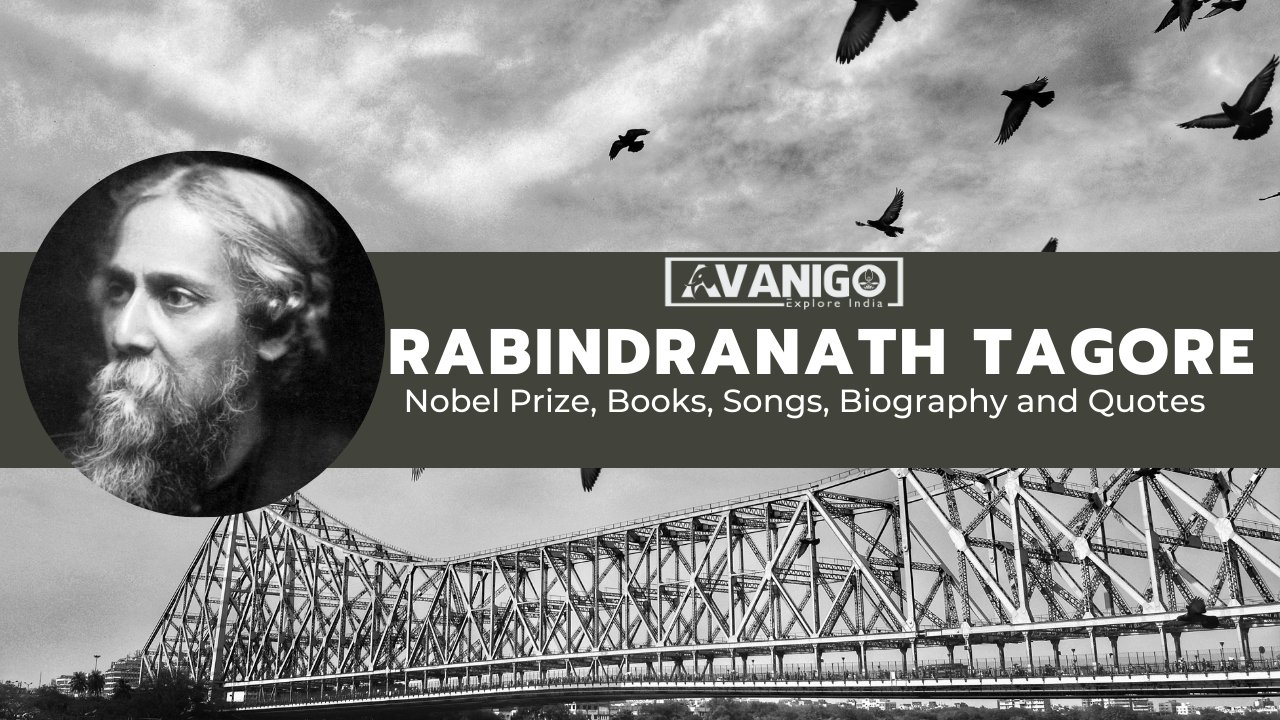How does one individual leave such an immense, diverse legacy that continues to inspire the world decades after? To truly understand Rabindranath Tagore biography, facts and multifaceted greatness, we must delve deeper into the fascinating life of this extraordinary soul who epitomized the Renaissance spirit. Hailed as ‘Gurudev’, Tagore was that rare polymath – a prolific writer, insightful philosopher, musical maestro, pioneering educator and vocal reformer who modernized his beloved Bengal.
Quick Navigation
Rabindranath Tagore Biography
On a pleasant day, May 7, 1861, Calcutta welcomed a unique soul – Rabindranath Tagore. Born to prominent parents Debendranath and Sarada Devi, young Rabi was destined for great things. Rabindranath Tagore’s father, Debendranath, was renowned for establishing the progressive Brahmo Samaj society many years prior, spreading enlightened ideas far and wide.
Meanwhile, Rabindranath Tagore’s mother, Sarada Devi, descended from a prestigious family deeply immersed in Bengali culture. Surrounded by such pioneering figures, young Rabi imbibed open-minded values from an early age. This nurturing environment of spirituality, arts and progressive thought would mould his free-thinking character in the future.
Tagore received his early education at home under private tutors and freely explored literature, history, and religious scriptures. Tagore was then sent to England in 1878 by his father to study law, but he still needed to complete his studies and focused more on literature instead.
After returning to India, Tagore married Mrinalini Devi when she was ten in 1883. He started managing his large family estate and ventured into literature, composing poetry and stories. Later, in Santiniketan, Tagore established a school called “Patha Bhavana,” which developed into Visva Bharati University over time.
The difficulties migrants faced during the 20th-century famines that afflicted India deeply affected him. He arranged relief efforts and made lengthy tours to assist the general public. In addition, Tagore supported internationalism via education, opposed communalism, and engaged in political activism. He lived an extraordinary life, inspiring thousands, and achieved peace on August 7, 1941.
Rabindranath Tagore Books
Tagore was a prolific writer known for pioneering modern Bengali literature and reshaping its traditions and norms. Here are some of Rabindranath Tagore’s books across genres:
Gitanjali (Song Offerings): This collection of poems attained Tagore international fame by winning the Nobel Prize. Through simple lyrics, it beautifully expressed spiritual longings, contemplations on mortality, and devotion to the divine in a style that profoundly moves readers globally. Its mystic meditations in communion with nature were praised for enriching English poetry.
Ghare Baire (The Home and the World): In one of his celebrated novels, Tagore showcased societal dilemmas that remained all too relevant. The tale follows a couple navigating challenges emerging within their marriage, partly due to the wife joining revolutionary activities during India’s call for independence. Ahead of its time, the work highlighted Tagore’s nuanced perspective on issues still debated today – nationalism, cultural bonds and shifting identities.
Gora: This thought-provoking novel was set in the context of colonial Bengal and explores complex questions around religious identity. Its multi-layered protagonist, Gora, embarks on an emotional journey of self-discovery as he confronts societal biases regarding caste and spiritual conversion. The book’s insightful depictions of cultural collision were far ahead of its time.
Sonar Tari (Golden Boat): This charming collection of short stories provides intimate glimpses into relationships and village life in early 20th-century Bengal. Tagore uses simple prose and witty dialogues to bring his characters to life, many dealing with issues like oppressive social customs or adjusting to modern changes. Readers relate to the stories’ heartfelt commentary on human emotions.
Ghare Bou (Homecoming): This moving poetry collection reflects Tagore’s deep bond with nature and seasons through vivid imagery. Poems like ‘Aaj Surer Din’ or ‘Moner Manush’ tap into universal feelings of nostalgia, impermanence, and reconnection with nature’s rhythms. Readers have found meditative solace in its skilful portrayal of introspective moods.
Chaturanga: A story portraying Tagore’s progressive ideals, it dealt with taboo subjects like women’s education and inter-caste romance in contemporary Indian society. Readers appreciated its balanced treatment of complex social themes through well-developed characters and their emotional journeys.
Kabuliwala: This moving story highlights the common humanity that unites a young Bengali girl and an Afghan dry fruit vendor through their odd bond. Its simplicity and celebration of childhood innocence in life’s fragilities have affected generations of readers.
Rabindranath Tagore Nobel Prize
It was momentous when Tagore’s talent crystallized on the global stage. In 1913, the Nobel Committee awarded him its highest Literature honour – a first for Asia. Their choice fell upon Gitanjali, Tagore’s exquisite poetry collection expressing life’s meaning to God and nature through poignant symbols.
Thanks to translators like Yeats, Rabindranath Tagore’s Gitanjali’s simple yet profoundly stirring verses touched souls internationally. Its sincere meditations on existence exemplified how art transcends borders to connect diverse minds.
Tagore had introduced India’s literary treasures to the global consciousness well and truly. In that watershed moment, the world gained a beloved poet – and India found a timeless voice to showcase its heritage to all humanity.

Achievements and Awards of Rabindranath Tagore
Tagore’s selection demonstrated how an Indian artistic work could be appreciated globally for its universal spiritual and literary qualities. He also own many achievements and accomplishments in his cap:
National Anthem of India
- Long before India raised its tricolour flag to the world, Tagore had envisioned a united land cherishing diversity in his songs.
- One lyrical composition in particular echoed India’s spirit deeply – ‘Jana Gana Mana‘ was chosen as the national anthem in 1947.
- Its moving invocation of all Indians inspires patriotism to this day. Long live the nation that honours such a visionary as its voice.
Homage to the Motherland
- Bangladesh, too, found representation of its spirit in Tagore’s masterful works.
- ‘Amar Shonar Bangla’ stood as a testament to his undying love for the land, capturing its essence so profoundly that it was selected as Independent Bangladesh’s anthem in 1971.
- Through Tagore’s words, a new nation was born with an anthem acknowledging his poetic tribute to Bangladesh’s beauty and pride.
- All hail the humble bard who uplifted the spirits of not one but two lands.
Design of Indian National Flag
- Even India’s tricolour design hints at Tagore’s seminal influence – its hues reportedly drew from one of his most famous poems describing tranquil futures.
- Such was the power of Tagore’s vision that it continued informing a country’s identity long after his departure.
- Though holding no office, Tagore’s status as Bengal’s ‘Poet Laureate’ and ‘Bard’ illuminates how deeply he shaped its soul and consciousness through art for eternity. That, indeed, is the mark of an immortal genius.
Rabindranath’s Songs to India
- Tagore was also a highly gifted composer besides being a wordsmith par excellence. He composed over 2,000 songs, which are collectively known as Rabindra Sangeet.
- These exquisite songs became extremely popular not just in Bengal but across India. Two of his most renowned compositions are Amar Shonar Bangla and Jana Gana Mana, adopted as the national anthems of Bangladesh and India.
- Tagore’s melodies blended classical ragas with traditional folk tunes, bringing a uniquely soulful quality. His songs carried profoundly moving reflections on universal themes like joy, sadness, seasons, nature, and devotion.
- They represented Tagore’s philosophy that music can transcend linguistic barriers and connect people through emotional resonance.
The Lasting Legacy of Santiniketan
- Among Tagore’s most significant achievements was founding Visva-Bharati, a large university town near Santiniketan. It was built on Tagore’s vision of scientific yet liberal education, emphasizing arts, humanities, nature, and community living.
- Shantiniketan is a pioneering institution was characterized by open-air classrooms under trees, cultural performances, and seminars from scholars worldwide.
- Some key aspects that enrich Santiniketan exceptionally are its emphasis on linking education with the villages through extension work like popular education programs, including Nobel laureates, local crafts, culture within the curriculum, and Western concepts.
- Shantiniketan represented an ideal holistic learning space focused on the harmonious development of mind, body, and spirit. Visva-Bharati continues Tagore’s legacy today by being Asia’s only UNESCO World Heritage Site-recognized university.
Rabindranath Tagore Quotes
“We come nearest to the great when we are great in humility.”
“If you cry because the sun has gone out of your life, your tears will prevent you from seeing the stars.”
“You can’t cross the sea merely by standing and staring at the water.”
“The butterfly counts not months but moments, and has time enough.”
“Reach high, for stars lie hidden in you. Dream deep, for every dream precedes the goal.”
“Don’t limit a child to your own learning, for she was born in another time.”
A Soulful Voice Championing Peace
Throughout his life, Rabindranath Tagore biography tells us that he was a profound humanitarian thinker who advocated his universal brotherhood philosophies through his creative works and non-violent actions. This reflects with the Indian Philosophy of Vasudhiava Kutumbakam.
Tagore staunchly opposed divisive nationalism and pushed for international cooperation and understanding between cultures. During lectures abroad, he emphasized the critical need to reconcile progressive ideas from the East and West.
Tagore rejected a knighthood in response to the Jallianwala Bagh massacre in 1919, showing his rebellious yet peaceful stance against British imperialism. His impact was such that he was invited to present India’s perspective regarding peace and disarmament at the 1925 Geneva Conference. Tagore’s ceaseless efforts helped shape India’s non-aligned stance during the Cold War as a leading voice of the Global South. Even in today’s geopolitical scenario, Tagore’s messages offer sagacious guidance for global solidarity and diplomacy.
Tagore worked tirelessly for India’s famine relief through donations and fundraising tours and managed relief camps. His holistic philosophies on education, arts, spirituality, environment, and global connectivity remain profoundly insightful.
Rabindranath Tagore is an Icon who lives forever
The magnitude of Rabindranath Tagore biography influence is evident from the widespread remembrance of this iconic person. Annual tribute conventions are held at Santiniketan on his birth anniversary. Monuments stand at Rabindra Bhavan, Kolkata, and throughout Visva-Bharati.
Many institutions worldwide are also named after Tagore. His invaluable contributions paved the way for modern Indian cultural assertiveness while pushing humanity toward universal brotherhood, even during the most challenging times. Rabindranath Tagore was indeed one of India’s most honourable sons.
Swetha is a Content Specialist, LinkedIn Branding and B2B Marketing Consultant. When she is not in the world of B2B, she researches the roots and beauty of Indian Culture and Traditions. She is the author of the book: 365 Days 365 Posts – The Guide to LinkedIn Personal Branding, available exclusively on Amazon. Connect with her on LinkedIn.

